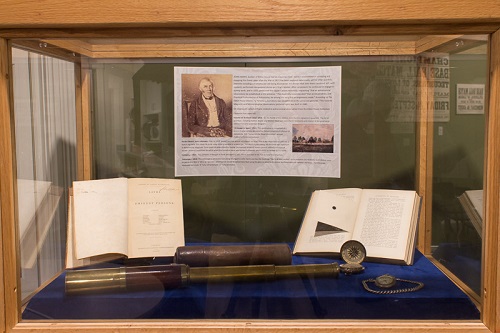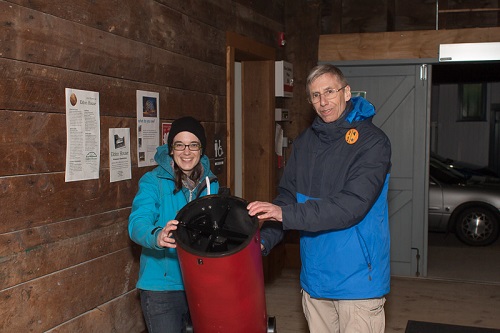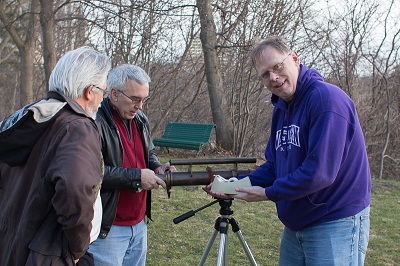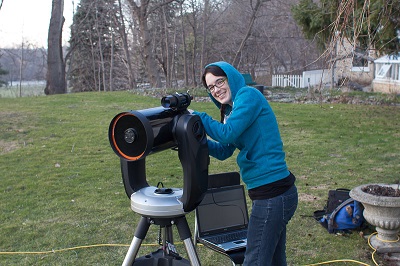By Robert Duff

Display Case at Eldon House
On Sunday evening, April 12th, 2015, 19th Century Star Gazing for Yuri Gagarin Night “Yuri’s Night” was celebrated at London’s Eldon House. The evening began with a presentation in the Interpretive Centre, 8:00 p.m., followed by stargazing with period and modern telescopes, 8:30—10:30 p.m. This event celebrated Cosmonaut Yuri Gagarin, the first man in space, who orbited the Earth in a Soviet Vostok spacecraft on April 12th, 1961. It was also a celebration of 180 years since Eldon House was built in 1834 by Master John Harris, Royal Navy, who surveyed the Great Lakes following the War of 1812.
RASC London Centre members Mark Tovey and Tricia Colvin made history come alive, dressed in period costume as Master John Harris and Amelia Harris. Event organizer and historian Mark Tovey began the evening around 8:00 p.m. with a slide presentation in the Eldon House Interpretive Centre. There were 52 visitors who registered ($15.00) for the evening.
John Harris’ recently discovered mariner’s telescope was on display, along with his compass and reproductions of the maps he and his fellow hydrographers were involved with. The hydrographers used occultation timings of Jupiter’s Galilean moons to help establish local longitude. John Harris also made a request to the government in Toronto for a permanent astronomical observatory to be built in Upper Canada. Graduate students Tony Martinez and Emily McCullough and faculty member Paul Wiegert, from Western University’s Department of Physics and Astronomy were on hand to provide expertise and demonstrations, and answer questions. Planetary scientists from Western University’s Centre for Planetary Science and Exploration (CPSX), including Phil McCausland and Haley Sapers and graduate student Bianca D’Aoust were also there, providing a large display of meteorites, globes, charts, and maps, and demonstrating a scale model of the solar system.
As the sky darkened guests were invited to view through 3 period telescopes including a working replica of Galileo’s (1609) telescope, made by RASC London Centre’s Dave McCarter; a replica spy glass similar to the one used by John Harris, supplied by London RASC Centre member Patrick Whelan; and a 1920s-era brass refractor from Western University’s Physics and Astronomy Department. There were also modern telescopes available for observation.
The sky was generally clear with some hazy clouds. There were 8 RASC London Centre members who brought telescopes. Tricia Colvin and Mark Tovey set up the Cronyn Observatory’s 8-inch (20.3cm) Meade 2080/ LX3 Schmidt-Cassegrain as well as the London Centre’s 25.4cm Dobsonian, kept at the Cronyn Observatory. They also set up Mark’s 8-inch (20.3cm) Celestron CPC 800 GPS Schmidt-Cassegrain and graduate student Emily McCullough worked on setting it up with the Cronyn Observatory’s Celestron NexImage 5 Solar System Imager, laptop computer and large computer screen to display the view through the telescope. Emily did succeed in displaying live images of Jupiter on the laptop (but not on the large computer screen) for the visitors.
| RASC London Centre member Bob Duff arrived around 7:00 p.m. and set up his 25.4cm Dobsonian telescope (with assistance from Paul Wiegert). Western University’s Physics and Astronomy Department computer resources person Henry Leparskas was also there with a camera, taking pictures. |
Emily McCullough and Bob Duff |
|
Tony Martinez (Left) looks on as Steve Gauthier (Middle) and Peter Jedicke (Right) set up the brass refractor using hi-tech space tape |
RASC London Centre members Peter Jedicke and Steve Gauthier arrived with Western University’s antique brass refractor, which they set up on a camera tripod. Joe O’Neil videoed the site in the early evening with a drone and set up his 80mm Stellarvue refractor on an alt-azimuth mount. Roman Dubinski set up his Sky-Watcher 127mm Maksutov on a Vixen alt-azimuth mount. Patrick Whelan set up his compact ball-shaped Bushnell Voyager 4.5-inch reflector telescope on a folding table, provided by Eldon House, along with his 40mm Tasco refractor from the 1960’s. Richard Gibbens was also there and listened to the talk by Mark Tovey in the Interpretive Centre. |
Following Mark’s presentation in the Interpretive Centre, people came out on the west lawn of Eldon House to view through the telescopes. Bob showed them Venus in the early evening western sky. Venus appeared slightly gibbous at half-phase in Bob’s 20.3cm Dobsonian telescope (7mm Nagler eyepiece, 174X). He soon redirected the telescope towards Jupiter which remained the showpiece of the evening. People lined up to view Jupiter through the 25.4cm Dobsonian (7mm Nagler eyepiece, 174X). There were 3 Galilean moons visible, including Europa to the west (left) and Ganymede and Callisto to the east (right) of Jupiter. The Great Red Spot was visible on Jupiter’s surface, much to everybody’s delight. The moon Io emerged from eclipse by Jupiter’s shadow around 9:12 p.m. (April 13th, 2015, 1:12 UT) just as John Harris would have observed for calculating local longitude. Bob later combined his 2X Meade Barlow lens with the 7mm Nagler eyepiece in his 20.3cm Dobsonian telescope to double the magnification on Jupiter to 348X. The view of Jupiter was still sharp at 348X, although there was a slight loss of contrast on its surface cloud belts due to the slight sky haze.
Roman Dubinski showed people Venus and the Pleiades star cluster, both in the same field of view in his 127mm Maksutov. Roman used his laser pointer to show them the constellations Orion, Auriga and Gemini. Visitors also viewed Jupiter through the Cronyn Observatory’s 8-inch (20.3cm) Meade Schmidt-Cassegrain, operated by Tricia Colvin, and the London Centre’s 25.4cm Dobsonian, operated by Peter Jedicke. Peter mentioned that one former long-time member reintroduced himself to the RASC London Centre volunteers!
|
Tricia Colvin and Mark Tovey pose in period attire |
Visitors were deeply impressed by Mark’s presentation, the historic artifacts and the display of meteorites. They greatly enjoyed the opportunity to view Jupiter through the replica of Galileo’s telescope set up on Dave McCarter’s stand and supervised by graduate student Tony Martinez, appropriately dressed as Galileo and with a newly grown beard for the occasion! They most especially enjoyed the views of Jupiter through modern telescopes. Emily McCullough gave a sky tour with a laser pointer and explained calculating longitude to a group of people towards the end of the evening. Paul Wiegert showed visitors how to use a sextant, and spoke about latitude. Emily believed they came within one degree of accuracy to the true latitude and longitude of London using their observations from April 12th with the visitors at Eldon House. The visitors were gone by around 10:30 p.m. after a very enjoyable and interesting evening of astronomy and local history.
Emily McCullough sets up her scope |
All photos courtesy of Henry Leparskas. For more images like this from the event be sure to visit Henry’s Flickr page.





